Vermes in the 10th edition of Systema Naturae
Main article: 10th edition of Systema Naturae
In 1758, in the 10th edition of Systema Naturae, the Swedish scientist and taxonomist Carl Linnaeus described the class "Vermes" as:[1]
Animals of slow motion, soft substance, able to increase their bulk and restore parts which have been destroyed, extremely tenatious of life, and the inhabitants of moist places. Many of them are without a distinct head, and most of them without feet. They are principally distinguished by their tentacles (or feelers). By the Ancients they were not improperly called imperfect animals, as being destitute of ears, nose, head, eyes and legs; and are therefore totally distinct from Insects.
Linnaean Characteristics [2]
- Heart: 1 auricle, 0 ventricles. Cold, pus-like blood.
- Spiracles: obscure
- Jaw: various
- Penis: frequently hermaphrodites
- Organs of Sense: tentacles (generally), eyes, no brain, no ears, no nostrils
- Covering: calcareous or none, except spines
- Supports: no feet, no fins. Crawls in Moise Places & are Mute
The class Vermes, as Linnaeus conceived it, was a rather diverse and mismatched grouping of animals; basically it served as a wastebasket taxon for any invertebrate species that was not an arthropod. With the advent of the scientific understanding of evolution, it became clear that many of the animals in these groups were not in fact closely related, and so the class Vermes was dropped for several (at least 30) phyla.
Intestina
- Gordius (horsehair worms)

The common earthworm was named Lumbricus terrestris in 1758.
- Gordius aquaticus [3]
- Gordius argillaceus
- Gordius medinensis – Dracunculus medinensis [4]
- Furia
- Furia infernalis – Despite the many accounts of this purported animal by respected authorities, including Daniel Solander and Linnaeus himself, it is now accepted that no such animal exists.[5]
- Lumbricus (earthworms)
- Lumbricus terrestris – common earthworm
- Lumbricus marinus – lugworm
- Ascaris (giant intestinal roundworms)
- Ascaris vermicularis – pinworm
- Ascaris lumbricoides – giant roundworm
- Fasciola (liver flukes)
- Fasciola hepatica – sheep liver fluke
- Fasciola intestinalis
The sheep liver fluke was named Fasciola hepatica in 1758.
- Hirudo (leeches)
- Hirudo sanguisuga – Haemopis sanguisuga, horse leech
- Hirudo medicinalis – Hirudo medicinalis, European medicinal leech
- Hirudo octoculata - Erpobdella octoculata [6]
- Hirudo stagnalis - Helobdella stagnalis [7]
- Hirudo complanata - Glossiphonia complanata [8]
- Hirudo indica
- Hirudo geometra- Piscicola geometra [8]
- Hirudo muricata - Pontobdella muricata [9]
- Myxine (hagfishes)
- Myxine glutinosa – Atlantic hagfish
- Teredo (shipworms)
- Teredo lapidaria
- Teredo navalis – naval shipworm
Mollusca
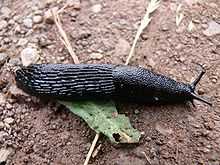
The black slug was named Limax ater in 1758.
- Limax (terrestrial slugs)
- Limax ater – Arion ater, the Black Slug
- Limax rufus – Arion rufus, the Red Slug
- Limax maximus – the Leopard Slug
- Limax agrestis – now Deroceras agreste
- Limax flavus – now Limacus flavus, the Yellow Slug
- Doris (dorid nudibranchs)
- Doris verrucosa – warty dorid
- Tethys (tethydid sea slugs)
- Tethys limacina
- Tethys leporina – Tethys fimbria
.jpg)
The beadlet anemone was named Priapus equinus in 1758.
- Nereis (polychaete worms)
- Nereis lacustris – Stylaria lacustris
- Nereis caerulea
- Nereis gigantea
- Nereis pelagica
- Nereis noctiluca
- Aphrodita (sea mice)
- Aphrodita squamata
- Aphrodita aculeata
- Lernaea (anchor worms)
- Lernaea cyprinacea [10]
- Lernaea asellina – Lernentoma asellina [10]
- Lernaea salmonea – Salmincola salmoneus [10]
- Priapus (priapulid worms & anemones)
- Priapus equinus – Beadlet anemone
- Priapus humanus – Priapulus caudatus
- Scyllaea (scyllaeid sea slugs)
- Scyllaea pelagica – Sargassum nudibranch
- Holothuria (salps & Man o' Wars)
- Holothuria physalis – Portuguese Man o' War
- Holothuria thalia, Holothuria caudata, & Holothuria denudata – Cyclosalpa pinnata
- Triton (triton snails)
- Triton littoreus

The common cuttlefish was named Sepia officinalis in 1758.
- Sepia (octopuses, squid, & cuttlefish)
- Sepia octopodia – Eledone cirrhosa, the Horned Octopus [11]
- Sepia officinalis – Sepia officinalis, the Common Cuttlefish
- Sepia media
- Sepia loligo - Loligo vulgaris, the Common Squid [12]
- Sepia sepiola - Sepiola rondeleti, the Dwarf Bobtail [13]
The moon jellyfish was named Medusa aurita in 1758.
- Medusa (jellyfish)
- Medusa porpita - Porpita porpita
- Medusa cruciata
- Medusa aequorea
- Medusa aurita – Aurelia aurita, the Moon Jellyfish
- Medusa capillata – Cyanea capillata, the Lion's Mane Jellyfish
- Medusa pilearis
- Medusa marsupialis - Carybdea marsupialis
- Medusa pelagica
- Medusa brachiata
- Medusa beroe
- Medusa velella - Velella velella
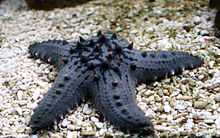
The horned sea star was named Asterias nodosa in 1758.
- Asterias luna - Anseropoda rosacea
- Asterias rubens – Asterias rubens, the Common Starfish
- Asterias glacialis - Marthasterias glacialis
- Asterias reticulata - Oreaster reticulatus, the Red Cushion Sea Star
- Asterias nodosa – Protoreaster nodosus, the Horned Sea Star
- Asterias aranciaca - Astropecten aranciacus
- Asterias equestris - Hippasteria phrygiana
- Asterias laevigata – Linckia laevigata, the Blue Star
- Asterias planci – Acanthaster planci, the Crown-of-thorns Starfish
- Asterias ophiura - Ophiura ophiura, the Brittle-Star
- Asterias pectinata - Comatula pectinata
- Asterias multiradiata - Capillaster multiradiata
- Asterias Caput medusae - Gorgonocephalus caputmedusae

The black sea urchin was named Echinus lixula in 1758.
- Echinus (sea urchins & sand dollars)
- Echinus esculentus – Echinus esculentus, the Edible Sea Urchin
- Echinus globulus - Mespilia globulus
- Echinus sphaeroides
- Echinus gratilla – Tripneustes gratilla, the Collector Urchin
- Echinus lixula – Arbacia lixula, the Black Sea Urchin
- Echinus saxatilis
- Echinus diadema – Echinothrix diadema, the Diadema Yrchin
- Echinus cidaris – Cidaris cidaris
- Echinus mamillatus – Heterocentrotus mammillatus, the Slate Pencil Yrchin
- Echinus lucunter - Echinometra lucunter
- Echinus atratus - Colobocentrotus atratus
- Echinus spatagus - Metalia spatagus
- Echinus lacunosus - Schizaster lacunosus
- Echinus rosaceus – Clypeaster rosaceus
- Echinus reticulatus - Clypeaster reticulatus
- Echinus placenta - Arachnoides placenta
- Echinus orbiculus - Hemiheliopsis fonti
Testacea
- Chiton (chitons)
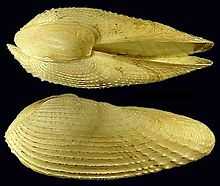
Barnea candida was named Pholas candidus in 1758.
- Chiton hispidus
- Chiton tuberculatus – West Indian green chiton
- Chiton aculeatus
- Chiton punctatus
- Lepas (barnacles)
- Lepas balanus – Balanus balanus [15]
- Lepas tintinnabulum – Megabalanus tintinnabulum [16]
- Lepas testudinaria – Chelonibia testudinaria [17]
- Lepas mitella – Capitulum mitella [18]
- Lepas anatifera [19]

The common softshell was named Myes arenaria in 1758.
- Pholas (piddocks & angelwings)
- Pholas dactylus – Pholas dactylus
- Pholas costatus
- Pholas striatus
- Pholas candidus – Barnea candida
- Pholas pusillus
- Myes (soft-shell clams)
- Myes crispata
- Myes truncata – truncate softshell
- Myes arenaria – common softshell
- Myes lutraria
- Myes pictorum
- Myes margaritifera
- Myes perna

The pod razor was named Solen siliqua in 1758.
- Myes vulsella
- Solen (razor clams)
- Solen vagina
- Solen siliqua – Pod razor
- Solen ensis
- Solen legumen
- Solen cultellus
- Solen radiatus
- Solen strigilatus
- Solen anatinus
- Solen bullatus
- Solen inaequivalvis
.jpg)
The Baltic tellin was named Tellina balthica in 1758.
- Tellina (tellins)
- Tellina gargadia
- Tellina linguafelis
- Tellina virgata
- Tellina gari
- Tellina fragilis – Gastrana fragilis
- Tellina albida
- Tellina foliacea
- Tellina planata
- Tellina laevigata – smooth tellin
- Tellina radiata – sunrise tellin
- Tellina rostrata
- Tellina trifasciata
- Tellina incarnata
- Tellina donacina – Donax tellin
- Tellina balaustina
- Tellina remies
- Tellina scobinata
- Tellina lactea
- Tellina carnaria
- Tellina bimaculata
- Tellina balthica – Baltic tellin
- Tellina pisiformis
- Tellina divaricata
- Tellina digitaria
- Tellina cornea
.jpg)
The common cockle was named Cardium edule in 1758.
- Cardium (cockles)
- Cardium costatum
- Cardium cardissa
- Cardium hemicardium
- Cardium medium
- Cardium muricatum – Acanthocardia aculeata
- Cardium echinatum – Acanthocardia echinata
- Cardium ciliare
- Cardium tuberculatum – Acanthocardia tuberculata
- Cardium isocardia
- Cardium fragum
- Cardium unedo
- Cardium muricatum
- Cardium magnum
- Cardium flavum
- Cardium laevigatum
- Cardium serratum
- Cardium triste
- Cardium corallinum
- Cardium solidum
- Cardium edule – common cockle
- Cardium rusticum
- Cardium pectinatum
- Cardium stultorum
- Cardium virgineum
- Cardium humanum
- Donax (wedge shells)

The hard clam was named Venus mercenaria in 1758.
- Donax pubescens
- Donax rugosa
- Donax trunculus
- Donax denticulata
- Donax cuneata
- Donax scripta
- Donax muricata
- Donax irus

The warty venus was named Venus verrucosa in 1758.
- Venus (Venus clams)
- Venus dione
- Venus marica
- Venus dysera
- Venus verrucosa – warty venus
- Venus casina
- Venus gallina – Chamelea gallina
- Venus petulca
- Venus erycina
- Venus mercenaria – hard clam
- Venus chione
- Venus maculata
- Venus meretrix
- Venus scortum
- Venus laeta
- Venus castrensis
- Venus phryne
- Venus meroë
- Venus deflorata
- Venus fimbriata
- Venus reticulata
- Venus squamosa
- Venus tigerina
- Venus prostrata
- Venus pensylvanica
- Venus incrustata
- Venus punctata
- Venus exoleta
- Venus orbicularis
- Venus ziczac
- Venus pectinata
- Venus scripta
- Venus edentula
- Venus lupinus
- Venus literata
- Venus rotundata
- Venus decussata
- Spondylus (thorny oysters)
- Spondylus gaederopus
- Spondylus regius
- Chama (jewel box shells)
- Chama lazarus
- Chama gigas
- Chama hippopus
- Chama antiquata
- Chama semiorbiculata
- Chama calyculata
- Chama cordata
- Chama oblonga
- Chama gryphoides
- Chama bicornis
- Arca (ark clams)
- Arca tortuosa
- Arca noae
- Arca barbata – Barbatia barbata
- Arca pella
- Arca lactea – Striarca lactea
- Arca antiquata
- Arca senilis
- Arca granosa
- Arca decussata
- Arca pallens
- Arca undata
- Arca pectunculus
- Arca glycymeris
- Arca nummaria
- Arca nucleus

The edible oyster was named Ostrea edulis in 1758.
- Ostrea (true oysters)
- Ostrea maxima
- Ostrea jacobaea
- Ostrea ziczac
- Ostrea striatula
- Ostrea minuta
- Ostrea pleuronectes
- Ostrea obliterata
- Ostrea radula
- Ostrea plica
- Ostrea pallium
- Ostrea nodosa
- Ostrea pes felis
- Ostrea pellucens
- Ostrea sanguinea
- Ostrea varia
- Ostrea pusio
- Ostrea glabra
- Ostrea opercularis
- Ostrea gibba
- Ostrea flavicans
- Ostrea fasciata
- Ostrea lima
- Ostrea isognomum
- Ostrea malleus
- Ostrea folium – Pycnodonta folium
- Ostrea orbicularis
- Ostrea edulis – edible oyster
- Ostrea semiaurita
- Ostrea ephippium

The blue mussel was named Mytilus edulis in 1758.
- Anomia (saddle oysters)
- Anomia craniolaris
- Anomia pectinata
- Anomia ephippium
- Anomia cepa
- Anomia electrica
- Anomia squamula – prickly jingle
- Anomia scobinata
- Anomia aurita
- Anomia retusa – Terebratulina retusa
- Anomia gryphus
- Anomia pecten
- Anomia striatula
- Anomia reticularis
- Anomia plicatella
- Anomia crispa
- Anomia lacunosa
- Anomia fareta
- Anomia caput serpentis
- Anomia terebratula
- Anomia angulata
- Anomia hysterita
- Anomia biloba
- Anomia placenta
- Mytilus – (Mussels including marine and freshwater mussels)
- Mytilus crista galli
- Mytilus hyotis
- Mytilus frons
- Mytilus margaritiferus – freshwater pearl mussel
- Mytilus unguis
- Mytilus lithophagus
- Mytilus bilocularis
- Mytilus exustus
- Mytilus barbatus
- Mytilus edulis – blue mussel
- Mytilus ungulatus
- Mytilus modiolus
- Mytilus cygneus – swan mussel (a freshwater mussel)
- Mytilus anatinus – duck mussel (a freshwater mussel)
- Mytilus viridis
- Mytilus ruber
- Mytilus hirundo

The chambered nautilus was named Nautilus pompilius in 1758.
- Pinna (pen shells)
- Pinna rudis – rough penshell
- Pinna nobilis
- Pinna muricata
- Pinna rotundata
- Pinna saccata
- Pinna digitiformis
- Pinna lobata
- Pinna pennacea
- Argonauta (paper nautiluses)
- Argonauta argo – greater argonaut
- Argonauta cymbium

The marbled cone was named Conus marmoreus in 1758.
- Nautilus (Nautiluses)
- Nautilus pompilius – chambered nautilus
- Nautilus crista
- Nautilus calcar
- Nautilus crispus
- Nautilus beccarii
- Nautilus umbilicatus
- Nautilus spirula – Spirula spirula
- Nautilus Semi-Lituus
- Nautilus obliqvus
- Nautilus raphanistrum
- Nautilus raphanus
- Nautilus granum
- Nautilus radicula
- Nautilus fascia
- Nautilus sipunculus
- Nautilus legumen
- Nautilus orthocera
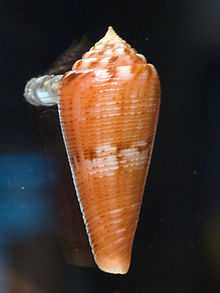
The Glory-of-the-Atlantic cone was named Conus granulatus in 1758.
- Conus (Cone Snails)
- Conus marmoreus – marbled cone
- Conus imperialis – imperial cone
- Conus litteratus – lettered cone
- Conus virgo
- Conus capitaneus
- Conus miles
- Conus princeps
- Conus ammiralis
- Conus senator
- Conus nobilis
- Conus genuanus
- Conus glaucus
- Conus monachus – Conus achatinus
- Conus minimus
- Conus rusticus
- Conus mercator
- Conus betulinus
- Conus figulinus
- Conus ebraeus – black-and-white cone
- Conus stercus muscarum – Conus stercusmuscarum
- Conus varius
- Conus spinosus
- Conus clavus
- Conus nussatella – Nussatella cone
- Conus granulatus – Glory-of-the-Atlantic cone
- Conus aurisiacus
- Conus magus
- Conus striatus – striated cone
- Conus textile – cloth of gold cone
- Conus aulicus
- Conus spectrum
- Conus bullatus – bubble cone
- Conus tulipa
- Conus geographus – geography cone
- Conus terebellum – Terebellum terebellum
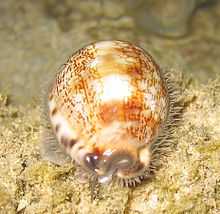
The Arabian cowry was named Cypraea arabica in 1758.

The gnawed cowry was named Cypraea erosa in 1758.
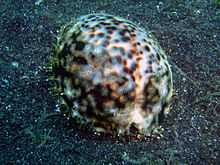
The tiger cowry was named Cypraea tigris in 1758.
- Cypraea (Cowries)
- Cypraea mappa – map cowry
- Cypraea arabica – Arabian cowry
- Cypraea argus
- Cypraea testudinaria – turtle cowry
- Cypraea stercoraria
- Cypraea carneola – Carnelian cowry
- Cypraea zebra – measled cowry
- Cypraea talpa – mole cowry
- Cypraea amethystea
- Cypraea lurida
- Cypraea vanelli
- Cypraea lota
- Cypraea fragilis
- Cypraea caput serpentis – serpent's-head cowry
- Cypraea mauritiana – humpback cowry
- Cypraea vitellus
- Cypraea mus
- Cypraea tigris – tiger cowry
- Cypraea lynx
- Cypraea isabella – Luria isabella
- Cypraea onyx
- Cypraea succincta
- Cypraea ziczac
- Cypraea hirundo
- Cypraea asellus
- Cypraea cribraria
- Cypraea errones
- Cypraea moneta – money cowry
- Cypraea caurica
- Cypraea annulus – gold ringer
- Cypraea erosa – gnawed cowry
- Cypraea helvola – honey cowry
- Cypraea spurca
- Cypraea stolida – stolid cowry
- Cypraea ocellata
- Cypraea flaveola
- Cypraea poraria
- Cypraea pediculus
- Cypraea nucleus
- Cypraea staphylaea – stippled cowry
- Cypraea cicercula
- Cypraea globulus
- Bulla (bubble shells)
- Bulla ovum
- Bulla volva
- Bulla spelta
- Bulla verrucosa
- Bulla gibbosa
- Bulla naucum
- Bulla hydatis
- Bulla ampulla
- Bulla lignaria
- Bulla physis
- Bulla amplustre
- Bulla pallida
- Bulla canaliculata
- Bulla fontinalis
- Bulla hypnorum
- Bulla cypraea
- Bulla tornatilis
- Bulla achatin
- Bulla Auris Midae
- Bulla Auris Judae
- Bulla solidula
- Bulla livida
- Bulla coffea

Mitra paupercula was named Voluta paupercula in 1758.
- Voluta (volutes)
- Voluta porphyria
- Voluta oliva
- Voluta ispidula
- Voluta persicula
- Voluta monilis
- Voluta miliaria
- Voluta faba
- Voluta glabella
- Voluta mercatoria
- Voluta rustica
- Voluta paupercula – Mitra paupercula
- Voluta mendicaria
- Voluta tringa
- Voluta cornicula
- Voluta caffra
- Voluta sanguisuga
- Voluta vulpecula
- Voluta plicaria
- Voluta pertusa
- Voluta mitra episcopalis
- Voluta mitra papalis
- Voluta musica – music volute
- Voluta vespertilio
- Voluta ebraea – Hebrew volute
- oluta aethiopica – Melo aethiopica
- Voluta cymbium
- Voluta olla

The dog whelk was named Buccinum lapillus in 1758.
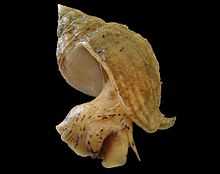
The common whelk was named Buccinum undatum in 1758.
- Buccinum (true whelks)
- Buccinum olearium – Tonna galea
- Buccinum galea
- Buccinum perdix
- Buccinum pomum – Malea pomum
- Buccinum dolium
- Buccinum echinophorum
- Buccinum tuberosum
- Buccinum plicatum
- Buccinum cornutum
- Buccinum rufum
- Buccinum flammeum
- Buccinum testiculus
- Buccinum decussatum
- Buccinum areola
- Buccinum erinaceus
- Buccinum glaucum
- Buccinum vibex
- Buccinum papillosum
- Buccinum glans
- Buccinum arcularia – Nassarius arcularia
- Buccinum pullus – Nassa pulla
- Buccinum gibbosulum
- Buccinum mutabile
- Buccinum neriteum
- Buccinum harpa – Harpa harpa
- Buccinum costatum – Harpa costata
- Buccinum persicum – Purpura persica
- Buccinum patulum
- Buccinum lapillus – dog whelk
- Buccinum smaragdulus – Leucozonia smaragdula
- Buccinum spiratum
- Buccinum glabratum
- Buccinum virgineum
- Buccinum praemorsum
- Buccinum undosum – Cantharus undosus
- Buccinum undatum – common whelk
- Buccinum reticulatum
- Buccinum scabriculum
- Buccinum nitidulum
- Buccinum laevigatum
- Buccinum maculatum – Oxymeris maculata
- Buccinum crenulatum
- Buccinum hecticum – Impages hectica
- Buccinum strigilatum – Hastula strigilata
- Buccinum duplicatum – Duplicaria duplicata
- Buccinum dimidiatum – Acus dimidiata
- Buccinum murinum
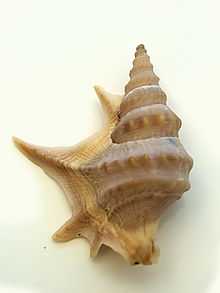
The pelican's foot was named Strombus pes pelecani in 1758.
- Strombus (true conchs)
- Strombus pes pelecani – pelican's foot
- Strombus chiragra – Lambis chiragra
- Strombus scorpius – Lambis scorpius
- Strombus lambis – Lambis lambis
- Strombus millepeda – Lambis millepeda
- Strombus lentiginosus – silver conch
- Strombus gallus – Aliger gallus
- Strombus auris dianae – Strombus aurisdianae
- Strombus pugilis – West Indian fighting conch
- Strombus marginatus
- Strombus luhuanus – strawberry conch
- Strombus gibberulus – humpbacked conch
- Strombus lucifer
- Strombus gigas – Eustrombus gigas
- Strombus latissimus
- Strombus epidromis
- Strombus canarium
- Strombus vittatus
- Strombus urceus
- Strombus dentatus
- Strombus ater
- Strombus lividus
.jpg)
The banded dye murex was named Murex trunculus in 1758.
- Murex (Murex Snails)
- Murex haustellum – Haustellum haustellum
- Murex tribulus
- Murex cornutus – Bolinus cornutus
- Murex brandaris – purple dye murex
- Murex trunculus – banded dye murex
- Murex ramosus – ramose murex
- Murex scorpio – scorpion murex
- Murex saxatilis
- Murex erinaceus – European sting winkle
- Murex rana – Bufonaria rana
- Murex gyrinus – Gyrineum gyrinum
- Murex lampas – Charonia lampas
- Murex oleariú
- Murex femorale – Cymatium femorale
- Murex lotoriú – Lotoria lotoria
- Murex pileare
- Murex rubecula – Septa rubecula
- Murex scrobilator – Bursa scrobilator
- Murex reticularis – Distorsio reticularis
- Murex pyrum – Ranularia pyrum
- Murex anus – Distorsio anus
- Murex ricinus
- Murex capitellum
- Murex turbinellus
- Murex nodus
- Murex hystrix
- Murex mancinella – Purpura mancinella
- Murex ceramicus
- Murex hippocastanum – Thais virgata
- Murex melongena
- Murex scabriculus
- Murex senticosus
- Murex ficus – Ficus ficus
- Murex rapa
- Murex granum
- Murex fusus
- Murex babylonius
- Murex colus – distaff spindle
- Murex morio
- Murex cochlidium
- Murex canaliculatus
- Murex aruanus – Australian trumpet
- Murex perversus
- Murex antiqvus
- Murex despectus
- Murex tritonis
- Murex tulipa – Fasciolaria tulipa
- Murex pusio
- Murex corneus
- Murex ligniarius – Fasciolaria lignaria
- Murex trapezium – Pleuroploca trapezium
- Murex syracusanus – Fusinus syracusanus
- Murex craticulatus – Turrilatirus craticulatus
- Murex scriptus
- Murex aluco – Pseudovertagus aluco
- Murex fuscatus
- Murex radula
- Murex asper – Rhinoclavis aspera
- Murex granulatus
- Trochus (top snails)
- Trochus maculatus – maculated top shell
- Trochus perspectivus
- Trochus hybridus
- Trochus cruciatus
- Trochus pharaonius – strawberry top shell
- Trochus magus
- Trochus modulus
- Trochus muricatus
- Trochus scaber
- Trochus varius – Gibbula varia
- Trochus cinerarius
- Trochus divaricatus
- Trochus umbilicaris – Gibbula umbilicaris
- Trochus vestiarius
- Trochus labio
- Trochus tuber
- Trochus striatus
- Trochus conulus – Calliostoma conulus
- Trochus zizyphinus – Calliostoma zizyphinum
- Trochus telescopium
- Trochus dolabratus
- Trochus perversus
- Trochus punctatus
- Trochus striatellus – Jujubinus striatus

The great green turban was named Turbo marmoratus in 1758.

The West Indian top shell was named Turbo pica in 1758.
- Turbo (turban snails)
- Turbo obtusatus – flat periwinkle
- Turbo neritoides
- Turbo littoreus
- Turbo muricatus – Cenchritis muricatus
- Turbo cimex
- Turbo pullus
- Turbo personatus
- Turbo petholatus
- Turbo cochlus
- Turbo chrysostomus
- Turbo tectum persicum
- Turbo pagodus
- Turbo calcar
- Turbo marmoratus – great green turban
- Turbo sarmaticus
- Turbo olearius
- Turbo pica – West Indian top shell
- Turbo sanguineus – Homalopoma sanguineum
- Turbo argyrostomus
- Turbo margaritaceus
- Turbo delphinus
- Turbo distortus
- Turbo scalaris
- Turbo clathrus
- Turbo crenatus
- Turbo lacteus
- Turbo striatulus
- Turbo uva
- Turbo corneus
- Turbo reflexus
- Turbo lincina
- Turbo imbricatus
- Turbo replicatus
- Turbo acutangulus
- Turbo duplicatus – Turritella duplicata
- Turbo exoletus – Turritella exoleta
- Turbo terebra – Turritella terebra
- Turbo variegatus – Turritella variegata
- Turbo ungulinus
- Turbo annulatus – Pyrgula annulata
- Turbo bidens – Papillifera bidens
- Turbo perversus
- Turbo muscorum – Pupilla muscorum
- Turbo auriscalpium
- Turbo politus

The Roman snail was named Helix pomatia in 1758.
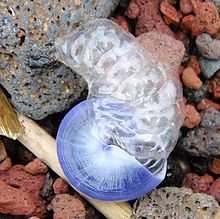
The common purple snail was named Helix janthina in 1758.
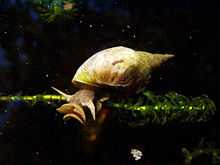
The great pond snail was named Helix stagnalis in 1758.
- Helix (land snails)
- Helix scarabaeus
- Helix lapicida
- Helix oculus capri
- Helix albella
- Helix striatula
- Helix algira – Zonites algirus
- Helix leucas
- Helix planorbis
- Helix complanata
- Helix ringens
- Helix carocolla
- Helix cornu militare
- Helix vortex
- Helix scabra – Littoraria scabra
- Helix gothica
- Helix gualtierana
- Helix cornea
- Helix spirorbis
- Helix contorta
- Helix cornu arietis
- Helix hispida
- Helix ampullacea
- Helix pomatia – Roman snail
- Helix glauca
- Helix citrina
- Helix arbustorum
- Helix ungulina
- Helix itala
- Helix hispana
- Helix lutaria – Helix lutescens
- Helix perversa
- Helix janthina – common purple snail
- Helix vivipara – Viviparus contectus a freshwater snail
- Helix nemoralis – grove snail
- Helix lucorum
- Helix grisea
- Helix haemastoma
- Helix decollata – decollate snail
- Helix pupa
- Helix barbara
- Helix amarula
- Helix stagnalis – great pond snail
- Helix fragilis
- Helix putris
- Helix limosa
- Helix tentaculata – common bithynia
- Helix auricularia – big-ear radix
- Helix balthica
- Helix neritoidea
- Helix perspicua
- Helix haliotoidea
- Helix ambigua

The blotched nerite was named Nerita albicilla in 1758.

Shell & opercula of Nerita peloronta
- Neritha (nerites)
- Nerita canrena
- Nerita glaucina
- Nerita vitellus
- Nerita albumé
- Nerita mammilla
- Nerita nodosa – Thais nodosa
- Nerita corona
- Nerita radula
- Nerita cornea
- Nerita fluviatilis
- Nerita littoralis
- Nerita lacustris
- Nerita bidens
- Nerita viridis
- Nerita virginea
- Nerita polita
- Nerita peloronta – bleeding tooth
- Nerita albicilla – blotched nerite
- Nerita histrio
- Nerita plicata
- Nerita grossa
- Nerita chamaeleon
- Nerita undata
- Nerita exuvia – snakeskin nerite
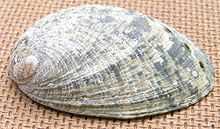
The virgin paua was named Haliotis marmorata in 1758.
- Haliotis (abalones)
- Haliotis midae
- Haliotis tuberculata – green ormer
- Haliotis striata
- Haliotis varia
- Haliotis marmorata – virgin paua
- Haliotis asinina – ass's ear abalone
- Haliotis parva
The brachiopod Lingula anatina was named Patella unguis in 1758.
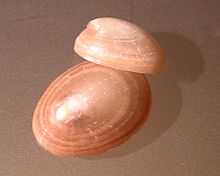
The blue-rayed limpet was named Patella pellucida in 1758.
- Patella (true limpets & brachiopods)
- Patella equestris
- Patella neritoidea
- Patella chinensis
- Patella porcellana
- Patella fornicata
- Patella laciniosa – Siphonaria laciniosa
- Patella saccharina
- Patella barbara – Scutellastra barbara
- Patella granularis – Scutellastra granularis
- Patella granatina – Cymbula granatina
- Patella vulgata – common limpet
- Patella caerulea
- Patella tuberculata
- Patella ungarica
- Patella mammillaris
- Patella pectinata – striped false limpet
- Patella lutea
- Patella unguis – Lingula anatina
- Patella lacustris
- Patella pellucida – blue-rayed limpet
- Patella testudinaria – Cellana testudinaria
- Patella compressa – Cymbula compressa
- Patella rustica
- Patella fusca
- Patella notata – Clypidina notata
- Patella cruciata
- Patella reticulata
- Patella fissura – common slit limpet
- Patella pustula
- Patella graeca – Greek keyhole limpet
- Patella nimbosa
- Patella nubecula
- Dentalium (tusk shells)
- Dentalium elephantinum
- Dentalium dentalis
- Dentalium entalis – Antalis entalis
- Dentalium minutum
- Serpula (serpulid worms)
- Serpula seminulum
- Serpula planorbis
- Serpula spirillum
- Serpula spirorbis
- Serpula triquetra – Pomatoceros triqueter
- Serpula intricata
- Serpula contortuplicata
- Serpula glomerata – Petaloconchus glomeratus
- Serpula lumbricalis – Petaloconchus adansoni
- Serpula arenaria – Serpulorbis arenarius
- Serpula anguina – Tenagodus anguinus
- Serpula penis veneris
- Serpula penicillus
- Serpula ringens
Lithophyta
- Tubipora (organ pipe corals)
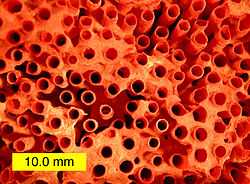
The organ pipe coral was named Tubipora musica in 1758.
- Tubipora musica – Organ pipe coral
- Tubipora infundibuliformis
- Tubipora verrucosa
- Tubipora urceus
- Tubipora serpens
- Tubipora repens
- Tubipora arenosa
- Millepora (Fire corals)
- Millepora cellulosa
- Millepora lichenoides
- Millepora damicornis
- Millepora alcicornis
- Millepora reticulata
- Millepora lineata
- Millepora compressa
- Millepora muricata
- Millepora eschara
- Millepora crustacea
- Madrepora (stone corals)
- Madrepora acetabulum – Acetabularia acetabulum
- Madrepora verrucaria
- Madrepora turbinata
- Madrepora fungites
- Madrepora pileus
- Madrepora maeandrites
- Madrepora labyrinthiformis
- Madrepora areolata
- Madrepora punctata
- Madrepora agaricites
- Madrepora truncata
- Madrepora stellaris
- Madrepora polygama
- Madrepora favosa
- Madrepora astroites
- Madrepora organum
- Madrepora flexuosa
- Madrepora turbinata
- Madrepora fascicularis
- Madrepora ananas
- Madrepora pertusa
- Madrepora ramea
- Madrepora rubra
- Madrepora oculata
- Madrepora virginea
Zoophyta
- Isis (soft corals)
- Isis hippuris
- Isis dichotoma
- Isis ocracea
- Isis anastatica
- Isis encrinus
- Gorgonia (sea fans)
- Gorgonia spiralis
- Gorgonia ventalina – Common Sea Fan
- Gorgonia flabellum – Venus Sea Fan
- Gorgonia antipathes
- Gorgonia ceratophyta
- Gorgonia pinnata
- Gorgonia aenea
- Gorgonia placomus
- Gorgonia abies
- Alcyonium (soft corals)
- Alcyonium arboreu
- Alcyonium digitatu
- Alcyonium bursa
- Tubularia (Tubularia)
- Tubularia indivisa – Tall Tubularia
- Tubularia ramosa
- Eschara (Bryozoa)
- Eschara foliacea
- Eschara fistulosa
- Eschara fragilis
- Eschara divaricata
- Eschara verticillata
- Corallina (coralline algae)
- Corallina opuntia
- Corallina officinalis
- Corallina squamata
- Corallina corniculata
- Corallina barbata
- Corallina fragilissima
- Corallina rubens – Jania rubens
- Corallina cristata
- Corallina spermophoros
- Corallina penicillus
- Sertularia (Bryozoa)
- Sertularia rosacea
- Sertularia pumila
- Sertularia operculata
- Sertularia tamarisca
- Sertularia abietina
- Sertularia cupressina
- Sertularia argentea
- Sertularia avicularia
- Sertularia rugosa
- Sertularia halecina
- Sertularia thuja
- Sertularia eburnea – Crisia eburnea
- Sertularia cornuta
- Sertularia myriophyllum
- Sertularia falcata
- Sertularia pluma
- Sertularia antennina
- Sertularia verticillata
- Sertularia volubilis
- Sertularia cuscuta
- Sertularia uva – Walkeria uva
- Sertularia lendigera
- Sertularia geniculata
- Sertularia dichotoma
- Sertularia spinosa
- Sertularia pinnata
- Sertularia polyzonias
- Sertularia setacea
- Sertularia stipulata
- Sertularia pennaria
- Sertularia lichenastrum
- Sertularia cedrina
- Sertularia purpurea
- Sertularia flexuosa
- Sertularia bursaria
- Sertularia loricata
- Sertularia fastigiata
- Sertularia neritina – Bugula neritina
- Sertularia scruposa
- Sertularia reptans
- Sertularia ciliata
- Sertularia chelata
- Sertularia anguina – Aetea anguina
- Sertularia polypina
- Hydra polypus
- Hydra campanulata
- Hydra socialis
- Hydra stentoria
- Hydra pyraria
- Hydra convallaria
- Hydra crataegaria
- Hydra opercularia
- Hydra umbellaria
- Hydra berberina
- Hydra digitalis
- Pennatula (sea pens)

The chlorophyte Volvox was included among the animals in the 1758 Systema Naturae as two species: Volvox globator & Volvox chaos
- Pennatula phosphorea
- Pennatula filosa
- Pennatula sagitta
- Pennatula mirabilis
- Taenia (tapeworms)
- Taenia solium – pork tapeworm
- Taenia vulgaris
- Taenia lata
- Taenia canina
- Volvox globator [20]
- Volvox chaos - Chaos chaos
References
- ↑ Carl von Linné, translated by William Turton (1806). Volume 4: Worms. A general system of nature: through the three grand kingdoms of animals, vegetables, and minerals, systematically divided into their several classes, orders, genera, species, and varieties. London: Lackington, Allen, and Co.
- ↑ Carl von Linné, translated by William Turton (1806). Volume 1. A general system of nature: through the three grand kingdoms of animals, vegetables, and minerals, systematically divided into their several classes, orders, genera, species, and varieties. London: Lackington, Allen, and Co.
- ↑ Gordius aquaticus at the Encyclopedia of Life
- ↑ F. E. G. Cox (2002). "History of Human Parasitology". Clinical Microbiology Reviews 15 (4): 595–612. doi:10.1128/CMR.15.4.595-612.2002. PMC 126866. PMID 12364371.
- ↑ Arthur de Capell Brooke (1827). "On the Furia infernalis". Edinburgh New Philosophical Journal 3: 39–43.
- ↑ "Erpobdella octoculata (Linnaeus 1758)". Fauna Europaea. Retrieved January 11, 2011.
- ↑ Martin Lindsey Christoffersen (2009). "A catalogue of Helobdella (Annelida, Clitellata, Hirudinea, Glossiphoniidae), with a summary of leech diversity, from South America" (PDF). Neotropical Biology and Conservation 4 (2): 89–98. doi:10.4013/nbc.2009.42.04.
- ↑ 8.0 8.1
- ↑ WoRMS (2010). "Pontobdella muricata (Linnaeus, 1758)". World Register of Marine Species. Retrieved January 11, 2011.
- ↑ 10.0 10.1 10.2 G. Boxshall (2010). T. C. Walter & G. Boxshall, ed. "Lernaea Linnaeus, 1758". World Copepoda database. World Register of Marine Species. Retrieved October 4, 2010.
- ↑ P. Bouchet (2010). "Sepia octopodia Linnaeus, 1758". World Register of Marine Species. Retrieved January 11, 2011.
- ↑ http://biostor.org/reference/2731.text
- ↑ http://data.gbif.org/species/13870254
- ↑ C. Mah & H. Hansson (2010). C. L. Mah, ed. "Asterias Linnaeus, 1758". World Asteroidea database. World Register of Marine Species. Retrieved January 11, 2011.
- ↑ Carl August Nilsson-Cantell (1978). Cirripedia Thoracica and Acrothoracica. Issue 5 of Marine Invertebrates of Scandinavia. Universitetsforlag. p. 57. ISBN 978-82-00-01670-0.
- ↑ Dora P. Henry & Patsy A. McLaughlin (1986). "The Recent species of Megabalanus (Cirripedia: Balanomorpha) with special emphasis on Balanus tintinnabulum (Linnaeus) sensu lato." (PDF). Zoologische Verhandelingen 235: 1–69, figs. 1–14.
- ↑ Michael G. Frick & Arnold Ross (2001). "Will the real Chelonibia testudinaria please come forward: an appeal". Marine Turtle Newsletter 94: 16–17.
- ↑ T. Y. Leung & D. S. Jones (2000). "Barnacles (Cirripedia: Thoracia) from epibenthis substrata in the shallow offshore waters of Hong Kong". In Brian Morton. The marine flora and fauna of Hong Kong and Southern China V. Hong Kong University Press. pp. 105–127. ISBN 978-962-209-525-0.
- ↑ WoRMS (2010). "Lepas anatifera Linnaeus, 1758". World Register of Marine Species. Retrieved August 30, 2010.
- ↑ Guiry, M.D.; Guiry, G.M. (2008). "Volvox globator". AlgaeBase. World-wide electronic publication, National University of Ireland, Galway.
| ||||||||||